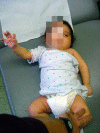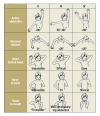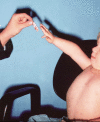Obstetric brachial plexus palsy: treatment strategy, long-term results, and prognosis
- PMID: 19562016
- PMCID: PMC2695299
- DOI: 10.3238/arztebl.2009.0083
Obstetric brachial plexus palsy: treatment strategy, long-term results, and prognosis
Abstract
Background: Obstetric brachial plexus palsy is rare, but the limb impairments are manifold and often long-lasting. Physiotherapy, microsurgical nerve reconstruction, secondary joint corrections, and muscle transpositions are employed with success. The role of conservative and operative treatment options should be regularly reviewed.
Methods: Selective literature review (evidence levels 3 and 4) and analysis of personal clinical operative and scientific experience over the past 15 years.
Results: Children with upper and total plexus palsy displaying nerve root avulsions and/or -ruptures are treated today by early primary nerve reconstruction in the first few months of life followed by secondary corrections, with good functional results. The late complications, with muscle weakness, impaired motion patterns, and joint dysplasia, are often underrated.
Conclusions: The potential for scientific analysis is limited, due to the rarity and interindividual variability of the lesions and the varying effects on function and growth. Expectations and compliance are different in every patient. Surgical techniques are not yet standardized. Knowledge of the consequences for joint growth and congruence is inadequate. Today, functional improvement can be achieved by surgery in most clinical manifestations of obstetric brachial plexus palsy, within the framework of an interdisciplinary treatment concept.
Keywords: microsurgery; nerve lesion; neurosurgery; obstetrics; trauma.
Figures





Similar articles
-
Perinatal brachial plexus palsy.Curr Opin Pediatr. 2000 Feb;12(1):40-7. doi: 10.1097/00008480-200002000-00009. Curr Opin Pediatr. 2000. PMID: 10676773 Review.
-
Current concepts in the management of brachial plexus birth palsy.J Hand Surg Am. 2010 Feb;35(2):322-31. doi: 10.1016/j.jhsa.2009.11.026. J Hand Surg Am. 2010. PMID: 20141905 Review.
-
International Federation of Societies for Surgery of the Hand Committee report: the role of nerve transfers in the treatment of neonatal brachial plexus palsy.J Hand Surg Am. 2015 Jun;40(6):1246-59. doi: 10.1016/j.jhsa.2015.01.027. Epub 2015 May 1. J Hand Surg Am. 2015. PMID: 25936735 Review.
-
Restoration of elbow extension after primary reconstruction in obstetric brachial plexus palsy.J Pediatr Orthop. 2010 Mar;30(2):161-8. doi: 10.1097/BPO.0b013e3181cf2e82. J Pediatr Orthop. 2010. PMID: 20179564
-
[Surgery of post-traumatic brachial plexus lesions (personal approach in 2003)].Handchir Mikrochir Plast Chir. 2004 Feb;36(1):29-36. doi: 10.1055/s-2004-817832. Handchir Mikrochir Plast Chir. 2004. PMID: 15083388 German.
Cited by
-
Personalized Use of an Adjustable Movement-Controlled Video Game in Obstetric Brachial Plexus Palsy during Physiotherapy Sessions at School: A Case Report.Healthcare (Basel). 2023 Jul 12;11(14):2008. doi: 10.3390/healthcare11142008. Healthcare (Basel). 2023. PMID: 37510449 Free PMC article.
-
Effect of exercise doses on functional recovery in neonatal brachial plexus palsy: A randomized controlled study.North Clin Istanb. 2018 Aug 7;6(1):1-6. doi: 10.14744/nci.2017.29200. eCollection 2019. North Clin Istanb. 2018. PMID: 31180384 Free PMC article.
-
Modified constraint induced movement therapy in children with obstetric brachial plexus palsy: a systematic review.Eur J Phys Rehabil Med. 2022 Feb;58(1):43-50. doi: 10.23736/S1973-9087.21.06886-6. Epub 2021 Nov 8. Eur J Phys Rehabil Med. 2022. PMID: 34747579 Free PMC article.
-
Does primary brachial plexus surgery alter palliative tendon transfer surgery outcomes in children with obstetric paralysis?BMC Musculoskelet Disord. 2011 Apr 13;12:74. doi: 10.1186/1471-2474-12-74. BMC Musculoskelet Disord. 2011. PMID: 21489264 Free PMC article.
-
Obstetric brachial plexus injury.Indian J Plast Surg. 2011 Sep;44(3):380-9. doi: 10.4103/0970-0358.90805. Indian J Plast Surg. 2011. PMID: 22279269 Free PMC article.
References
-
- Bahm J. Die kindliche Armplexusparese—Übersicht zur Klinik, Pathophysiologie und chirurgischen Behandlungsstrategie. Handchir Mikrochir Plast Chir. 2003;35:83–97. - PubMed
-
- Bahm J. Die kindliche Armplexusparese—Eine aktuelle Übersicht sekundärer Operationsverfahren. Handchir Mikrochir Plast Chir. 2004;36:37–46. - PubMed
-
- Antoniadis G, König RW, Mohr K, Kretschmer T, Richter HP. Management bei geburtstraumatischen Läsionen des Plexus brachialis—Eigene Erfahrungen mit der primären operativen Behandlung. Handchir Mikrochir Plast Chir. 2003;35:98–105. - PubMed
-
- Heilmann A, Krishnan KG, Heubner G, Pinzer Th, Schackert G, Gahr M. Therapeutisches Vorgehen bei geburtstraumatischer Plexus-brachialis-Läsion. Ärzteblatt Sachsen. 2003;9:423–426.
-
- Strömbeck C, Krumlinde-Sundholm L, Remahl S, Sejersen T. Long-term follow-up of children with obstetric brachial plexus palsy I: functional aspects. Dev Med Child Neurol. 2007;49:198–203. - PubMed
Publication types
MeSH terms
LinkOut - more resources
Full Text Sources
Medical
Miscellaneous

